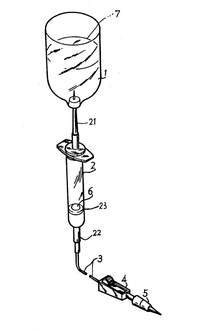
A Murphy drip is a rectal infusion apparatus to administer the medical procedure of proctoclysis, also known as rectoclysis.[2][3] During the procedure, an end of the Murphy drip is inserted into the rectum and large quantities of liquid are infused into the rectum drop by drop.[4] Prior to fluids or medicines being given intravenously, the Murphy drip and hypodermoclysis were the prime routes to administer fluids such as for replacement when patients could not be fed by mouth.[5] American surgeon John Benjamin Murphy introduced the drip method of saline infusion per rectum in the treatment of peritonitis.[6]
History
The Murphy drip was invented by Wisconsin surgeon John Benjamin Murphy, for the purpose of administering a proctoclysis for hydration and replenishment of electrolytes, via a sodium and calcium chloride solution. This would be used when administration by mouth was not possible because of the condition of the patient.[7] The Murphy drip was described in the April 1909 issue of the Journal of the American Medical Association.[8] By as early as July 1928, the Murphy drip was considered an auxiliary method of injection behind intravenous therapy and subcutaneous injection, the two principal methods of injection at that time.[9]

The Murphy drip can be used for administering drugs by this route and the apparatus is also used in conjunction with a catheter for bladder irrigation. The term can even be applied to apparatus used to administer fluids intravenously.[10]
A curious anecdote involving the Murphy drip is related by Walter Lord in his book on the Battle of Midway. On 4 June 1942 Pharmacist's Mate Edwin Miller was stationed on Sand Island (part of the Midway Atoll) and was making ready for the expected Japanese attack. Miller prepared undrinkably strong coffee which, he claimed, was to be used in an "old fashioned" treatment for shock – administration of strong coffee through the rectum via a Murphy drip. When the attack got underway, Miller was joined by his commanding officer and doctor in charge, Lieutenant Commander A. E. Ady, who did not appear to know the medical purpose of the coffee and asked for some to be poured. Miller thought that it would be amusing to let his commander drink it, but made the mistake of also drinking some himself. Dr. Ady continued to tell jokes throughout the attack. Miller, however, paid for his practical joke and was sick.[11]
Set-up
A description of a Murphy drip set-up is contained in the 1932 Kansas Supreme Court legal case Ratliffe v. Wesley Hospital and Nurses' Training School:[12]
On February 14, 1929, "Dr. Horn directed the nurse to use the proctoclysis, known as the “Murphy drip.” While the operation was in progress a student nurse in the employ of the hospital prepared the room for the return of the appellant. The proctoclysis set was a part of the equipment of the hospital and was assembled and placed at or near the foot of the bed by the student nurse. The proctoclysis set consists of a standard which is an iron pole setting on a tripod containing hooks at intervals, and on these hooks by means of a chain, tape, string, or piece of gauze is hung a can containing hot water and soda solution. From this can a tube extends which is inserted in the rectum of the patient to whom the proctoclysis is administered. It was necessary to keep the solution hot in order that it would have a body temperature after dropping through the tube and entering the body. ... It was not unusual for the vessel holding the water to be fastened to the standard by gauze, string, or other bandage, although a part of the vessels were equipped with chains."[12]
References
- ^ Yung-Feng Hung, Automatically closed dripping apparatus for intravenous administration, US patent 5 234 414, filed 28 September 1992, issued 10 August 1993
- ^ The American Heritage Medical Dictionary, 2007, Houghton Mifflin Company.
- ^ Zerwekh, Joyce. (February 1, 2003) Nursing. End-of-life hydration—benefit of burden? Volume 33; Issue 2; Page 1.
- ^ Saunders Comprehensive Veterinary Dictionary, 3 ed. 2007, Elsevier Inc.
- ^ Mullane, Mary K. (December 31, 2000) Nursing Forum A glance back in time. Volume 35; Issue 4; Page 41.
- ^ Rutkow, Ira M. (March 2001) Journal of the American Medical Association Moments in Surgical History: John Benjamin Murphy, 1857-1916. Arch Surg, March 2001; 136: 359.
- ^ Morgenstern, Leon, "John Benjamin Murphy (1857-1916): An American Surgical Phenomenon", Surgical Innovation, vol 13, No 1, pp1-3, Sage Publications, March 2006
- ^ Journal of the American Medical Association (April 17, 1909) Proctoclysys in the Treatment of Peritonitis (the Murphy Drip).
- ^ Homer R. Spence (November 3, 1933) California Courts of Appeal, First District, Division 2. Callahan v. Hahnemann Hospital. 26 P.2d 506.
- ^ "New Syphilis Cure", TIME Magazine, 22 April 1940, Time Inc. retrieved online 20 June 2008.
- ^ Lord, Walter, Midway: The Incredible Victory, pp98, 104, 105, Harper & Row 1967, ISBN 1-84022-236-0
- ^ a b Edward R. Sloan (May 7, 1932) Kansas Supreme Court. Ratliffe v. Wesley Hospital and Nurses' Training School. No. 30270. 135 Kan. 306. 10 P.2d 859.






